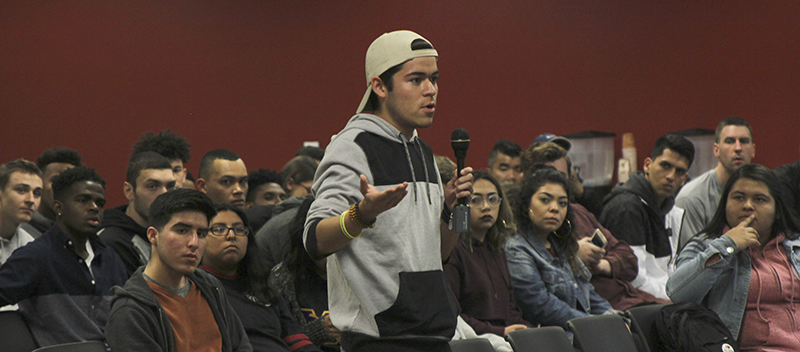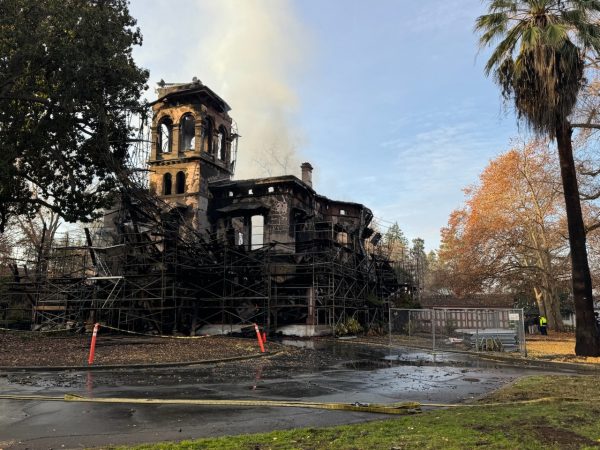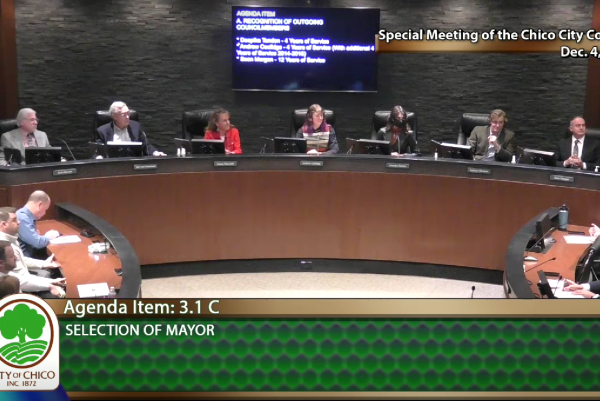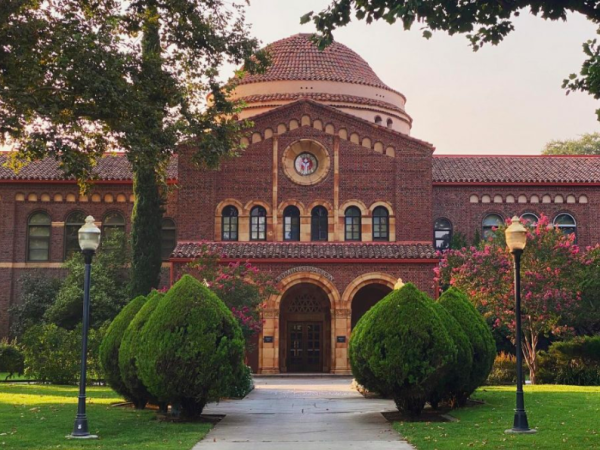Proposed fee increases could initially cost students up to $380 more per year
Aldon Perez, a freshman distance track and field athlete, speaks in favor of the student fee increases at an open forum on March 6.
On Wednesday around 8 a.m. students received a link in their email to submit an advisory vote on three proposed fee increases; a Health Services Fee, Student Learning Fee and an Athletics Fee.
Several students have expressed various emotions on each of these fees at five open forums this semester. Reactions have ranged from tears due to fear of unaffordable student fee increases to emotional stories of how athletics and the ‘Chico State experience’ have changed people’s lives.
Student fees are mandatory semester payments, separate from tuition, that each student is required to pay. They are the base funding for services the university provides that cannot be supported by tuition or state appropriations. According to the 2017-18 budget plan, students pay $1,606 in fees per year which is roughly a 175 percent increase from 10 years ago.
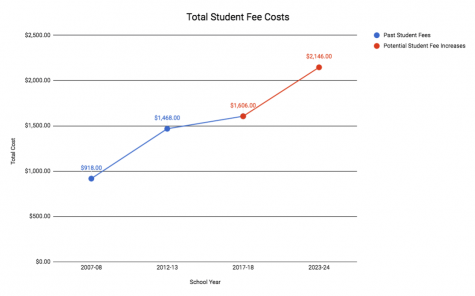
This chart shows the shows the past and present students fee rates. If all three student fees are passed then they will increase to at least $2,146 by the 2023-24 school year.
If passed, the three proposed increases will total to $190 per semester or $380 per year. Additionally, if these fees are implemented, they would follow a five-year gradual increase plan which would eventually total to $540 per year by the 2023-2024 school year.
With this potential $540 increase, students will be paying $2,146 in fees by 2023. This would be about a 234 percent increase in fee payments over the last 15 years.
In a higher education system full of student food and housing insecurity, these fee increases could be the difference between regular meals, making a rent payment, or being able to afford Chico State attendance costs.
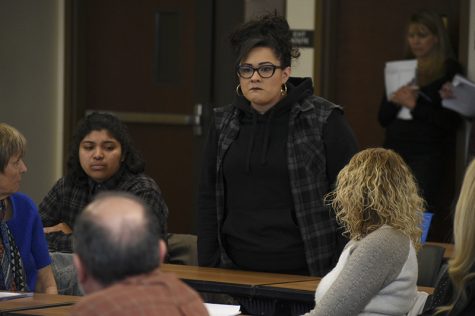
Student Cassandra Romero argues against the proposed fees at a forum on March 7 by saying that she came to Chico State because it was the one school that was affordable for her. If these fees were to increase, Romero said she wouldn’t be able to afford food costs on top of college expenses.
Students have been making these concerns known at open forums where President Gayle Hutchinson, Vice President for Student Affairs Milton Lang and other administrators have met to answer questions about the fees. It has not been an uncommon sight for students to come to tears at these forums, telling administrators they would not be able to attend Chico State next semester if these fees are implemented.
It has also not been uncommon for students to voice their approval for the student fees, speaking on the impact the Health Services Fee or Student Learning Fee has had on their life. The Athletics Fee has attracted Chico State athletes to the forums which often have made student-athletes the majority of attendees. Several student-athletes voiced their support for the athletics program and expressed the potential harm to the program if the Athletics Fee increase is not approved.
Any student involvement or voting is completely advisory.
There has also been a considerable concern by students and certain faculty members toward the process through which the student fees are being decided upon. While students can voice their opinions and advise administrators on what to do, Hutchinson ultimately will decide on whether the fees are implemented or not.
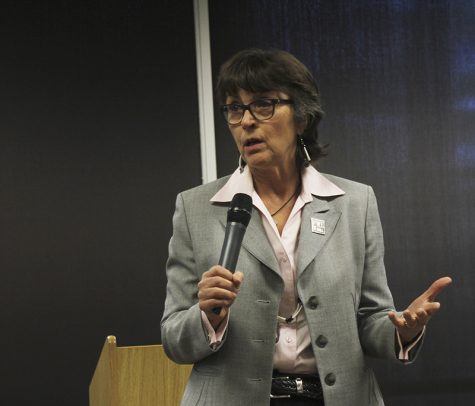
Gayle Hutchinson speaks on why the increased student fees are needed at the open forum on March 6. At each forum, Hutchinson stated that this increase was not due to any mismanagement of funds by past or current administrators.
Originally, Hutchinson decided to follow an “alternative consultation” process, through which she would receive advice from various student councils, but general student voices would be limited to suggestion cards and dialogue in the forums. After considerable blowback from students at the first few forums, Hutchinson sent out an email on March 5 announcing that the process would be switched to an “advisory student referendum.”
While this advisory student referendum will allow students to vote on the fee increases on Wednesday, the process is still completely advisory. Hutchinson will still have the final say as to whether these fee increases will be approved or not.
This has rubbed some people the wrong way, as students wish to have a say in a decision to pay more in fees for certain services. Historically there is a precedent for this, as the current Athletics Fee was implemented by a direct student vote in 1992. Students voted to tax themselves to preserve the athletics program, which was in danger of beingg cut due to insufficient state funding at the time.
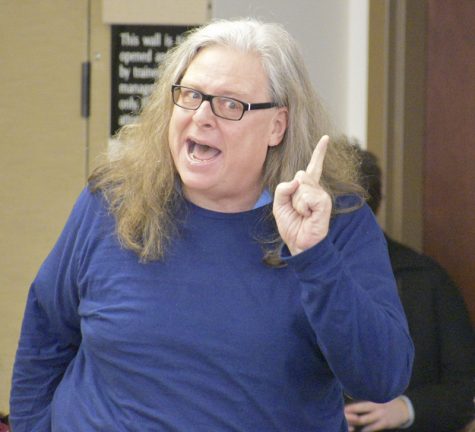
Michael Coyle, a political science and criminal justice professor, argues against Hutchinson’s claims that these proposed fee increases were not due to a mismanagement of funds at a forum on March 7. He also asked why the president makes half a million dollars while several professors are living off of “food stamps.”
Regardless, a link to the advisory student referendum will be sent out via email Wednesday at 8 a.m. and will be open until 8 p.m. on Thursday for students to share their opinion by voting. Each fee is being considered separately, so students will have the opportunity to vote separately on each of the three proposed increases.
To view the full chart below on a mobile device follow this link: https://create.piktochart.com/output/29804111-proposed-student-fees
Infograph made by Alex Grant
Each proposed student fee has a five-year increase plan after the initial increase but the hope is the three areas will be sustained for eight to 10 years.
Below is a breakdown of the individual proposed increases, with information gathered from university resources, the open forums and individual interviews of administrators.
Health Services Fee – Proposed $198 per year initial increase.
The Health Services Fee covers the funding of not only the Student Health Center, but the Counseling and Wellness Center and the Campus Alcohol and Drug Education Center.
Currently, all Chico State students pay $276 per year to fund these services. The proposed $198 fee increase would immediately bring the cost to $474 per year. After five years of cost escalation, students would be paying $564 per year for the Health Service Fee alone.
According to a fee proposal slideshow, the Student Health Services program is currently running a $2,379,000 deficit. This is in no small part due to the Student Health Services absorbing the cost of the Counseling and Wellness Center and CADEC over the last 15 years, as both of these programs were running at a serious cost to the university under the previous spending models.
As such, three separate programs have been operating off a budget that was originally only supposed to maintain just the Student Health Center.
Student health is of paramount importance, and the services provided by this fee make health services on campus both more affordable and more easily accessible. The mental health services provided by the Counseling and Wellness Center are of particular importance in a CSU system where student mental health is said to be one of the top priorities.
Still, it is this accessibility and affordability that is in question by students critical of the Health Services Fee increase. Waiting times are famously long at both the Student Health Center and the Counseling and Wellness Center, and appointments must be made weeks in advance for certain services.
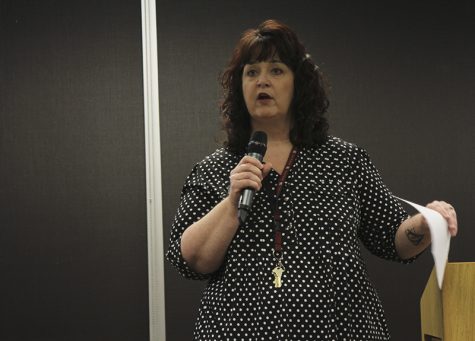
Interim Director of the Student Health Center Jill Cannaday explains to the forum crowd that students would be limited to three health center visits a semester if the proposed Health Service Fee increase isn’t approved.
It is with the additional funding that Interim Director for the Student Health Center Jill Cannaday wishes to tackle these extreme wait times. Cannaday has been the face around education and advocacy for the Health Services Fee increase, attending all the scheduled open forums and presenting the information around the Health Services Fee.
“If you go to the Health Center you see long lines at 8 o’clock,” she said at an open forum, “We don’t have enough providers, we don’t have enough nurses, we don’t have enough people in the lab. We need more people, and one way we can do that is to offer slightly more competitive salaries.”
“I’ve had positions that have been open for almost two years, and I can’t fill them because they’re so underpaid,” Cannaday added.
With this fee increase, Cannaday wishes to not only close the nearly $2.4 million gap in funding, but also to add additional staff in both the Student Health Center and the Counseling and Wellness Center to bring down wait times.
Additionally, the proposed increase would cover expanded hours, counseling hours during summer and would eliminate the summer visit fee.
Athletics Fee – Proposed $102 per year initial increase.
The Athletics Fee covers the funding of almost the entire athletics program, including intercollegiate athletes, recreational sports, intramural sports and club sports.
Currently, all Chico State students pay $194 per year to fund these services. The proposed $102 fee increase would immediately bring the cost to $296 per year. After five years of cost escalation, students would be paying $326 per year.
The risk for the program is difficult to understand for the casual observer. The university website shows the athletics program as only having a $90,000 deficit this year, a deficit that could be more than covered by a $6 increase per year for all students, instead of the allotted $102 a year increase.
However, this is misleading, by Director of Athletics Anita Barker’s own admission, the projected deficit does not include next year’s projections.
“This number is the minimum number,” Barker said. “We are right there at the cliff. That year that we go over the cliff, we’ll need $1.5 million.”
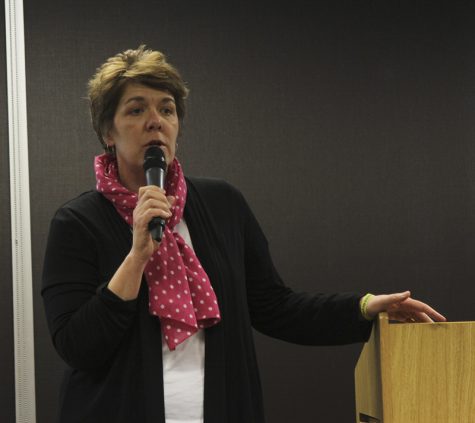
Athletic Director Anita Barker speaks at an open forum held on March 6 about how the current athletic fee is extremely outdated and needs to be increased.
Barker has led the charge in support of the proposed athletics fee increase, advocating for the importance of athletics program heartfeltly at the open forums, and defending the proposed increase from attacks from students who do not benefit from the athletics program.
The Athletics Fee has certainly been the most controversial fee of the proposed increases, with many students questioning why their fees need to be raised in support of such a specific section of students.
There are only about 350 student-athletes under the NCAA Division II intercollegiate athletic program, making up only 2 percent of students. There are additional students who benefit from the Athletics Fee, such as the over 4,000 students who utilize recreational sports, and the 1,100 students who are members of sports clubs.
However, the Athletics Fee also funds over 125 student employees who work within the student athletic program, a respectable amount of employment for a student body that has significant struggles with food and housing insecurity.
Altogether over 5,500 students are involved in some athletic program. Thus the Athletics Fee has brought passionate student voices in support of the fee increase at the open forums. Student-athletes are routinely one of the largest groups at every open forum meeting, bringing stories of how the athletics program has affected them and led them on paths to success.
These athletics students fear that if the proposed fee increases do not pass, the NCAA Division II program will be cut, essentially decimating the existing athletics program.
NCAA Division II requires the university to maintain at least 10 sports to participate in the intercollegiate program. Chico State currently maintains 13 intercollegiate sports and Barker has stressed at every forum that there is no way to cut three sports programs and continue to make the funding requirements.
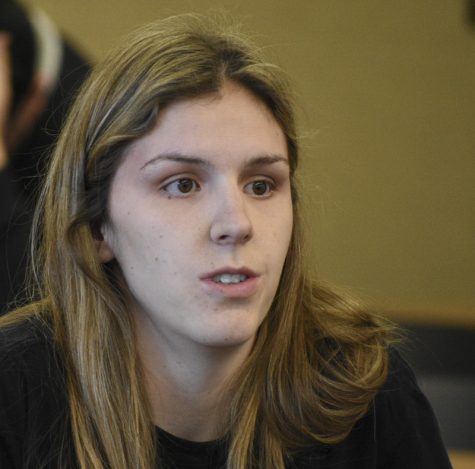
McKena Barker, a senior basketball player, speaks about how she grew up in Chico admiring Chico State’s sports teams at an open forum on March 7. Barker said these fees are not only essential to the college experience, but also to local youth that look up to college athletes.
As such, students must decide on the importance of athletics on campus. While the athletics program affects only a certain segment of the population, those who are benefitted by the program have been brought to tears at the open forums in defense of athletics.
The needs of these specific students must be weighed against the potential effects toward those who may not be able to afford these scheduled increases.
Student Learning Fee – Proposed $80 per year initial increase.
The Student Learning Fee covers the additional materials and costs of classes. Microscopes, scales, software, field trips, travel expenses and other equipment are all covered under the funding of this fee. Certain non-major specific materials and programs across campus are also funded by this fee, such as the new Makerspace at the Miriam Library.
Currently, all Chico State students pay $76 per year to fund these services. The proposed $80 fee increase would immediately bring the cost to $156 per year. After five years of cost escalation, students would be paying $236 per year.
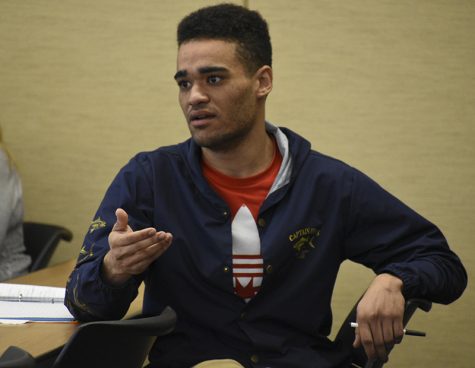
Political Science major Forrest Osburn asks the panel at a fee forum on March 7 about why low-income students would have to pay the same amount as students like himself who can afford the fee increases.
According to the university website, currently $2.4 million in requests cannot be funded, a number that grows every year. Prioritizations are made through administrative council decisions, leaving certain materials and programs up in the air. Certain tools and instruments do not get tagged for replacement within the classroom, leaving students with malfunctioning equipment for their core classes.
Additionally, there is less funding for state-of-the-art equipment and programs, creating a problem for students who need to use cutting-edge tools to stay competitive in the job market.
There have been certain criticisms made toward the equality of spending of the Student Learning Fee. By nature, STEM (science, technology, engineering and math) majors receive more funding as they require more tools and technology to be given a functional education. While all majors receive some amount of funding from the Student Learning Fee, STEM majors certainly receive a more sizable portion.
Inarguably, the Student Learning Fee provides an invaluable and necessary service to students. The argument is focused on the degree of spending, a battle between students’ needs and affordability.
To offset these costs to students, the Student Learning Fee has the largest allocation set aside for financial aid. 33 percent of the fee is reserved to go directly to students who meet the requirements for financial assistance. This means that of the $1,291,000 in fee funds anticipated for this school year, $426,000 of that money is set aside for financial aid.
Dean of Natural Sciences David Hassenzahl has taken the lead in advocating for the Student Learning Fees at the open forums. He’s noted the importance of Chico State’s system of handling additional classroom fees.
“Most institutions have course by course fees,” Hassenzahl said. “There was concern that we had all these little fees all over the place, and it was really hard for students to predict what it was going to cost to take different classes.”
“Everything was put together into a Consolidated Course Fee and Student Learning Fee and shared out on the basis of what programs need,” he added.
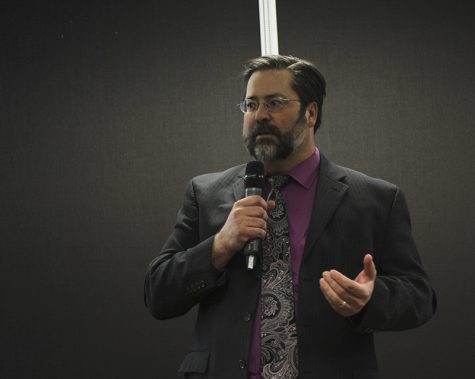
David Hassenzahl speaks of the important resources that students will get from the Student Learning Fee increase. Hassenzahl has spoken on behalf of this fee at every open forum to break down how it will benefit students.
Hassenzahl stated that the original concept of the Student Learning Fee was to take a lump sum from all students so it would be an equal fee for each student. This concept’s goal was to help students anticipate their total school expenses better rather than varying class by class fees that could catch certain students by surprise.
The Student Learning Fee represents the additional support students receive in their learning. It is the only proposed fee increase that has not been proposed in the face of an existing budgetary deficit, only a deficit of requests made that cannot be met with existing funds.
The decision is one based on the need for students to have quality materials and modern tools and programs, versus the cost these increases may have on students financial well being.
Students will have from 8 a.m. Wednesday until 8 p.m. Thursday to cast their advisory votes online. The Orion will update students on the results and which fee increases Hutchinson ultimately decides to approve.
Grayson Boyer can be reached at [email protected] or @theorion_news on Twitter.



